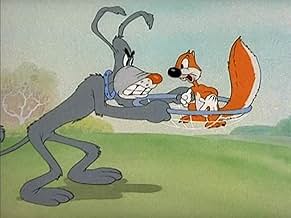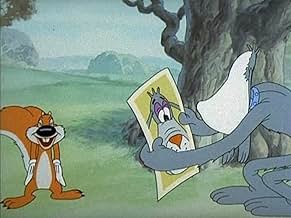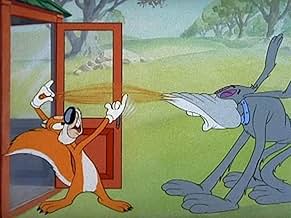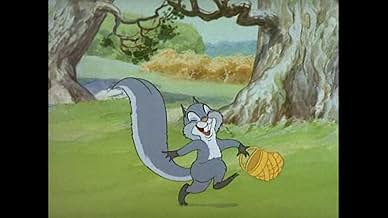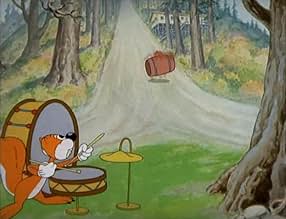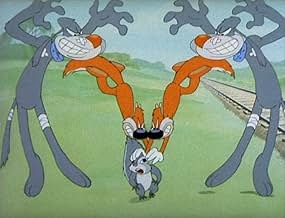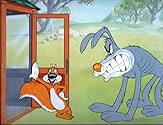IMDb RATING
7.1/10
1.2K
YOUR RATING
A screwy squirrel provokes a pedigreed birddog to chase him throughout the picture.A screwy squirrel provokes a pedigreed birddog to chase him throughout the picture.A screwy squirrel provokes a pedigreed birddog to chase him throughout the picture.
- Director
- Writer
- Stars
William Hanna
- Screwy Squirrel's Scream
- (uncredited)
Cal Howard
- Meathead
- (uncredited)
Wally Maher
- Screwy Squirrel
- (uncredited)
- …
- Director
- Writer
- All cast & crew
- Production, box office & more at IMDbPro
Featured reviews
Is it just me, or does squeaky clean Sammy Squirrel, who thinks this cartoon is going to be about him and his happy little friends, represent Walt Disney, or at least his cartoons? The salty Screwball takes him behind a tree and beats the daylights out of him, then provokes a dog named Meathead and beats him repeatedly too, all while being chased all over the place. There's a particular anarchy here and while Screwy lacks the charm of similarly characters (e.g. Bugs Bunny), I liked how the characters break the 4th wall and the alienation techniques Tex Avery used, e.g. The chase skipping when the record player begins to skip, or Screwy peeling back the image at a corner to see what he's going to be up to next. The gag with Meathead's entire face peeling off with flypaper was pretty amusing too. Not my favorite character, but worth seeing.
This is the first of several Screwball Squirrel cartoons. It's a real shame that this Tex Avery character never really took off, as I would have really loved to see more.
The cartoon begins with a cute little squirrel talking about the film and all his friends in the forest. Screwball then walks him away from the camera and beats the stuffing out of him and takes over the cartoon. He then phones and insults a bird dog so that through the rest of the film this hapless dog gets tortured repeatedly by Screwball. The film ends with the appearance of the same cute squirrel and BOTH Screwball and the dog pummel him!
The film is great because of all the Tex Avery touches--great over-the-top sight gags (such as catching the street car inside the tree) and the completely surreal aspects of the film. While it's not the best Avery cartoon (that might be SWINGSHIFT Cinderella), it is pure vintage Avery and fun for everyone but complete stick-in-the-muds.
The cartoon begins with a cute little squirrel talking about the film and all his friends in the forest. Screwball then walks him away from the camera and beats the stuffing out of him and takes over the cartoon. He then phones and insults a bird dog so that through the rest of the film this hapless dog gets tortured repeatedly by Screwball. The film ends with the appearance of the same cute squirrel and BOTH Screwball and the dog pummel him!
The film is great because of all the Tex Avery touches--great over-the-top sight gags (such as catching the street car inside the tree) and the completely surreal aspects of the film. While it's not the best Avery cartoon (that might be SWINGSHIFT Cinderella), it is pure vintage Avery and fun for everyone but complete stick-in-the-muds.
This was the first effort of Tex Avery to give us the character, "Screwy Squirrel." Reportedly, it was the answer to the popular Tom and Jerry cartoons at the time.
Man, this squirrel is a mean rodent, almost sadistic. His pleasure, apparently, is to torment this dog called "Meathead." This poor mutt takes a bad beating, time after time, and Screwy delights in doing whatever he can to him, followed by a sadistic laugh. I could see where that laugh could become annoying if you heard it often enough, but I don't remember much of it in the other SS cartoons I saw. I can also see why Screwy didn't become a hit, even though he was funny. As a leading cartoon character, he's just a little too nasty. However, Bugs Bunny inflicted a lot of pain on others, too, but they often - at least Elmer Fudd - started trouble. Plus, there was something lovable about Bugs. Here, this dog was just minding his own business when Screwy called him on the telephone and used some psychology to get him to come over.....only so he could abuse him. Now, that's mean!
As in most Tex Avery cartoons, the jokes are more adult-oriented and the director emphasizes, through another Thumper-like "Bambi" squirrel early in this cartoon, that is is not going to be a cute and fuzzy story. Avery once said he was "the anti-Disney" type and preferred his cartoons with an edge. Screwy beats up Thumper right away, just to emphasize the point.
Avery and his main writer, Heck Allen, also were good at having the main characters stop the story and talk to us - the audience - a number of times. That, or they would hold up a sign telling us something like, "Stupid, ain't it?" These "asides" to let us know what the characters are thinking are almost always clever and add to the cartoon's humor. I particularly thought it was neat when the character would comment that he knew all of this baloney that was happening on screen was just a cartoon anyway, so he'd make some wisecrack about "this cartoon this and that." Supposedly, this was the first time this sort of thing had ever been done in a cartoon. It must have really surprised audiences in the theater. That's how inventive Mr. Avery and Mr. Allen were with their animated short features. Their "Droopy" cartoons featured a lot of those "asides," too.
After watching this, I viewed two other "Screwy Squirrel" episodes and found them spectacular.
Man, this squirrel is a mean rodent, almost sadistic. His pleasure, apparently, is to torment this dog called "Meathead." This poor mutt takes a bad beating, time after time, and Screwy delights in doing whatever he can to him, followed by a sadistic laugh. I could see where that laugh could become annoying if you heard it often enough, but I don't remember much of it in the other SS cartoons I saw. I can also see why Screwy didn't become a hit, even though he was funny. As a leading cartoon character, he's just a little too nasty. However, Bugs Bunny inflicted a lot of pain on others, too, but they often - at least Elmer Fudd - started trouble. Plus, there was something lovable about Bugs. Here, this dog was just minding his own business when Screwy called him on the telephone and used some psychology to get him to come over.....only so he could abuse him. Now, that's mean!
As in most Tex Avery cartoons, the jokes are more adult-oriented and the director emphasizes, through another Thumper-like "Bambi" squirrel early in this cartoon, that is is not going to be a cute and fuzzy story. Avery once said he was "the anti-Disney" type and preferred his cartoons with an edge. Screwy beats up Thumper right away, just to emphasize the point.
Avery and his main writer, Heck Allen, also were good at having the main characters stop the story and talk to us - the audience - a number of times. That, or they would hold up a sign telling us something like, "Stupid, ain't it?" These "asides" to let us know what the characters are thinking are almost always clever and add to the cartoon's humor. I particularly thought it was neat when the character would comment that he knew all of this baloney that was happening on screen was just a cartoon anyway, so he'd make some wisecrack about "this cartoon this and that." Supposedly, this was the first time this sort of thing had ever been done in a cartoon. It must have really surprised audiences in the theater. That's how inventive Mr. Avery and Mr. Allen were with their animated short features. Their "Droopy" cartoons featured a lot of those "asides," too.
After watching this, I viewed two other "Screwy Squirrel" episodes and found them spectacular.
10llltdesq
Tex Avery preferred doing one-shot cartoons as opposed to using a regular character or characters. He was more interested in the gags than anything else. Studios, of course, want something recognizable to the audience, to developing continuing interest and thus sell more tickets. So Avery, because MGM wanted him to come up with a character to rival the Tom and Jerry shorts done by the other principle unit at the studio (Hanna and Barbera) came up with Screwball Squirrel.
While Screwy was a decent enough character, the trouble was that he was too limited, too much a one-note character. He was a walking sight gag. There were five cartoons done with Screwy before the series ended, in typical Avery style, with Lonesome Lenny. The Screwy cartoons are funny, but also too predictable. The first one, here, opens wonderfully with a lighthearted (or maybe not) shot at cutesy little animal cartoons that were staples at "other studios" for years and takes off from there. This is probably the best of the series. Well worth watching. Most highly recommended.
While Screwy was a decent enough character, the trouble was that he was too limited, too much a one-note character. He was a walking sight gag. There were five cartoons done with Screwy before the series ended, in typical Avery style, with Lonesome Lenny. The Screwy cartoons are funny, but also too predictable. The first one, here, opens wonderfully with a lighthearted (or maybe not) shot at cutesy little animal cartoons that were staples at "other studios" for years and takes off from there. This is probably the best of the series. Well worth watching. Most highly recommended.
I'm interested in how we imagine as a society, so study movies. I'm increasingly convinced that many of the cleverest folding ideas were introduced first through shorts, specifically cartoons. They were cheaper to produce and wouldn't drag down the bill if they failed.
1944 is a bit late in the game for the history of folding, so the experiments have to be outrageous.
This is. Superficially, it is a chase cartoon where the plucky small creature outwits and pummels the bigger, dumber one. I understand that the form was mandated by funders. Ignore it.
Much more interesting is how Tex wrapped that in a selfaware perspective.
It starts with a fight for control of the cartoon, one character saying: "what kind of cartoon is this anyway?"
Midway in the chase, the little guy the squirrel asks what the next scene will be, and literally lifts the page to see the cartoon underneath.
Near the end, the big dumb guy says that he's had enough and the cartoon is over. That shrinking iris effect begins, but the little guy begs for some more time. He makes a promise which is of course broken.
At the real end of the thing, the little guy comes on stage to talk to the audience and reveals that he was able to perform all those tricks because he had a twin. The final joke is that the big dog had one too (about which the screwy squirrel was unaware.)
Important stuff. Funny, engaging.
Ted's Evaluation -- 3 of 3: Worth watching.
1944 is a bit late in the game for the history of folding, so the experiments have to be outrageous.
This is. Superficially, it is a chase cartoon where the plucky small creature outwits and pummels the bigger, dumber one. I understand that the form was mandated by funders. Ignore it.
Much more interesting is how Tex wrapped that in a selfaware perspective.
It starts with a fight for control of the cartoon, one character saying: "what kind of cartoon is this anyway?"
Midway in the chase, the little guy the squirrel asks what the next scene will be, and literally lifts the page to see the cartoon underneath.
Near the end, the big dumb guy says that he's had enough and the cartoon is over. That shrinking iris effect begins, but the little guy begs for some more time. He makes a promise which is of course broken.
At the real end of the thing, the little guy comes on stage to talk to the audience and reveals that he was able to perform all those tricks because he had a twin. The final joke is that the big dog had one too (about which the screwy squirrel was unaware.)
Important stuff. Funny, engaging.
Ted's Evaluation -- 3 of 3: Worth watching.
Did you know
- TriviaScrewball squirrel breaks the fourth wall just after he dispenses with the too cute squirrel, and continues to do so throughout the short. The cute squirrel character is probably a veiled dig at Disney's "Bambi."
- GoofsOn the beached ship, Screwy paints a water/sky landscape on a placard to simulate the ship rocking by tipping the picture back and forth outside the porthole in order to make Meathead seasick. Watching Screwy, it is seen that he sometimes lifts the bottom of the painted placard above the bottom of the porthole window. However, when seen from inside the ship (where Meathead is), the view of the "water" (painted bottom of the placard) is unbroken.
- Quotes
Screwy Squirrel: Well, that's the end of him. You people want in on a little secret? You wanna know how I tricked that guy all through the picture?
[a second Screwy Squirrel appears]
Screwy Squirrel: [Both of them] We was twins all the time! Ha ha ha ha!
[Two Meatheads appear, each taking a hold of one of the Screwys]
Meathead: [Both of them] So was we. Ha ha ha ha!
Sammy Squirrel: My cartoon would have been cuter.
Screwy Squirrel, Meathead: Oh, brother, not that!
[They all beat up Sammy]
- ConnectionsEdited into Putty (1992)
Details
- Runtime
- 7m
- Aspect ratio
- 1.37 : 1
Contribute to this page
Suggest an edit or add missing content

